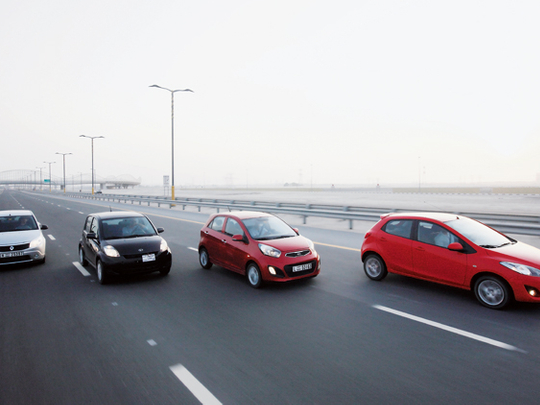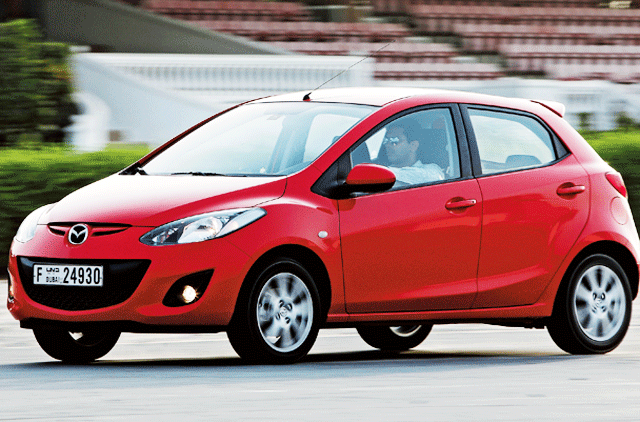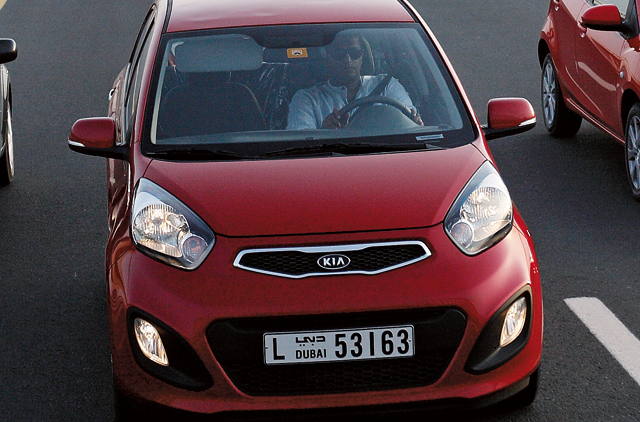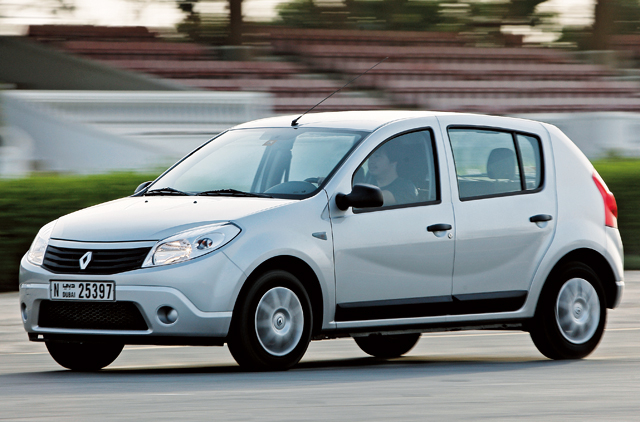
We've had a barrage of emails asking us to get serious and stop ‘wasting' our time with supercars and 500-plus horsepower super saloons. Some of you, it turns out, have actual lives, nine-to-five jobs, bills and kids. You have about 40 grand to spend on your next car, not 400.
Don't you lot worry about that: we finally dusted off our old sensible hats and got to work. Just in time, Kia gave us its revamped Picanto with a starting price of just Dh36K. So we got three other cars that sell for around the same amount to go head-to-head with the upstart Korean: a base Renault Sandero, a Mazda 2 and a Daihatsu Sirion.
Budget beater
When you pay peanuts, you get peanuts. So if someone offers you a deal for the peanut shells in your hand, you've no reason to expect actual peanuts in return. If your budget for a small car is below40 grand, but you won't settle for anything other than a European brand — Eastern European in the first case, as it's a rebadged Dacia — then your only option is the bare-bones base version of the Renault Sandero.
The Dh38,500 base trim car we tested has a gaping rectangular hole in the middle of the dashboard where the radio should've been, but it's got central locking, although the wing mirrors have to be adjusted manually. Thankfully it has an AC and, strangely enough, a snow mode button in the otherwise sparse centre console.
There is of course a better equipped SE version which comes with keyless entry, electric wing mirrors, and not just a radio, but a CD player as well as a leather-wrapped steering wheel (although our steering wheel was more than comfortable enough for daily use). But then again, the asking price climbs up to Dh46,500, which is Dh4,500 more than the top-spec version of the all-new Kia Picanto that packs in all these features in a decent-looking package. However, it's very likely that most of those who opt for the base version of a budget hatch will overlook these missing creature comforts. What they'll appreciate instead will be the decent performance of the 1.6-litre four-cylinder engine good for 104bhp and 148Nm of torque, and mated to a four-speed automatic gearbox in the Renault.
If you're used to the feather-touch electronic power steering systems in most of the modern cars you'll find steering the Sandero a bit of a workout. We found it refreshingly different though, complementing the decidedly old-school interior with an upright and unadorned dashboard and a plain steering wheel that does not incorporate a horn button. It's instead activated by pressing the end of the indicator stalk.
Once the engine gathers speed in about 12 seconds, the Sandero offers a pliant ride in straight highway cruises but it's advisable to be a bit less enthusiastic around bends and roundabouts as the car exhibits noticeable understeer. The lack of ABS and a passenger side airbag in the base Sandero doesn't help confidence either. But the engine is plenty gutsy over about 3,000rpm and makes up for its lack of torque below that with the highest total torque figure of all the cars here. And if you do not want to graduate to the SE trim, and you don't mind the drawbacks, the Sandero still comes with a spacious cabin and segment-leading boot space — 320 litres extendable up to 1,200 litres.
Korean to the core
On the other hand, there is nothing old-world about the Kia. It's a thoroughly modern design and a welcome departure from the boxy, uninspired car it succeeded. The second generation Picanto finally gets the Peter Schreyer touch and the ‘tiger nose' family face. It's not just in looks that the Kia has matured, it's actually a grown-up version of its predecessor. At 3,600mm, the overall length of the car has been increased by 60mm, while the wheelbase is 15mm longer than the old Picanto. Front legroom is up by 36mm and actually comfortable enough for six-foot drivers, but that also means the rear legroom suffers. The back seats also disappoint with their near-vertical positioning.
Although Kia says the boot space has been increased by 27 per cent, 200 litres is not much to write home about. Families with kids should note that you'll struggle to fit average-sized prams in there. The Middle East gets only one engine choice across four trim levels — that is the87bhp, 1.2-litre four-cylinder unit with a four-speed gearbox. With the maximum power available at an ear-shattering 6,000rpm, the Picanto is not as enthusiastic a performer as the looks suggest, and it pales in comparison with the superb Mazda 2 and, surprisingly, even the Daihatsu Sirion. It is a let-down, especially in the handling department with the electronic power steering offering not much useful feedback.
But where the little Korean impresses is in the technology that's been jam-packed into it. The LX variant we drove — the one below the top-spec trim — had all the usual features like keyless entry, power windows front and rear, and a lot more class-leading equipment such as electric folding mirrors with integrated indicators, Bluetooth, height-adjustable driver's seat and a leather-wrapped multi-function steering wheel. Apart from these, the top-of-the-line Picanto also comes with ABS, automatic headlights and a sunroof. But quite surprisingly, even the high-end version in the Middle East gets only one airbag. There isn't even one for the front passenger, while top-end models in other markets get up to six airbags.
Toyotsu or Daiyota?
As for the Daihatsu, we didn't even think of it until a day before this gathering. This kind of car just quietly goes about its business, selling through word of mouth and rummaging around town with rent-a-car stickers on its rear window. Why aren't we all making a fuss about the Sirion? It's an excellent little box of goodies. Firstly, it's quite literally a box. This design gives you a high seating position (in fact the highest here), excellent visibility, ease of egress and ingress, cleverly laid out seating and cargo access (well, apart from the full-size spare wheel which intrudes above the boot floor) and the best cup holders. No, really, that's important. The Daihatsu has cup holders in the middle console and on the sides of the dash, in front of the cooling vents. That's budget refrigeration right there. It also has a neat motorcycle-style instrumentation display that tilts up and down with the steering wheel. No telescopic adjustment though…
The centre console is dated, but you can't fault the layout or the packaging which leaves acres of room underneath the dash for your knees, dogs, bags or, more in custom with the local motoring culture, children. They'll be able to play down there for hours. The Sirion also has a double glovebox (so you can bring two pairs of gloves), and enough cubby holes for a class two hoarder. We love it because it's just so clever, and doesn't shout about it. Then there's the best bit. We tried all day to figure out why its 102bhp 1.5-litre four-pot with variable valve timing is so darned determined to please.
Even if you approach the Sirion with the words, "Eww, what the heck is that?" this car will make you love it. And then we went back to the office and actually looked at some of the press material. The powertrain is excellent, because it's a typical Japanese rev-happy four-pot with attention deficit disorder. Oh, and it's actually a Toyota lump. Which explains it, and means you can sit on the redline for 200,000km and all it will ever ask of you is a couple of oil changes, and maybe, only maybe, a timing belt.
Even the ancient four-speed automatic is forgivable when paired with this engine. Its 138Nm of torque is more than enough to get up to speed, because any speed feels too fast in the Sirion; its 14in wheels support Oreo-sized tyres and its diminutive size amplifies everything by three. So when you dive into a corner like a Messerschmitt ME109 at warp speed, and go WEEEEEEEE, the speedo is actually saying 40kph. You won't care. The front MacPherson strut and common-as-muck semi-independent torsion beam rear somehow feel like double wishbones. OK, not really, but the Sirion honestly does turn in, steer, and generally holds itself on the road brilliantly. Almost, but not exactly, as well as the Mazda 2.
Far eastern star
The Mazda 2 is the alpha male here, strutting its stuff with its mighty Ford Fiesta running gear. So why didn't we just bring along a Fiesta then? Because this looks better, and because it's newer. And also because we forgot to ask Ford… But anyway, the Mazda 2 recently trounced the Toyota Yaris in one of wheels' two-way comparison tests, so we thought we'd see what it could do amongst cheaper competition.
Honestly? It's awesome. Just when we thought the Toyota's… sorry, Daihatsu's 1.5-litre engine would be the deciding factor, we jumped in the Mazda 2 and sampled the sweetest mill here. It's not like it's well endowed or anything, but even with 101bhp it accelerates quicker than this other lot, and sprints out of corners faster. But that's probably only because you can simply carry more speed through the turns, because the Mazda 2 was engineered for European roads. That's why this thing delivers at every point of its rev band, working the four-speed automatic transmission likea treadmill.
And the handling? Oh boy, with just a handful of horses more and maybe some stickier rubber, we'd be calling this a hot hatch. Plus they managed to make it grip and grip in the bends, yet exhibit such composure over bumps that you'd think it had some kind of adaptive damping.
Of course, it doesn't. It's the same set-up as most of the other small cars around, yet it crests speedbumps without the need to brake, and sits true and level on the highway, soaking up any wallops.
The ride is the best out of this lot, no doubt, so is the steering feel (in fact it's the only car here with what we'd call any kind of useful steering communication). And then there's the design. How can you not love it? Look at it, it's always smiling at you with that ridiculous grille grin.
The cabin is also matched with a youthful style, although it's a bit too drab with black everything. It's also not nearly as practical as the Sirion's interior, or as spacious as the Renault's, or as kitted out as the Kia's. So it loses out there, but then you catch another glimpse of it in the mirrored building you just drove past and you're smiling again. And you'd think a focus on design would kill visibility but it doesn't — you've got front quarter windows here and you can see out in every direction, despite sitting lower than in the others.
Lastly, the Mazda 2 has a three-spoke steering wheel that reminds you of the MX-5 every time you grip its fat rim, and that's always good, plus the glovebox is two-tiered so one half is closed and the other open. Also, even though all of these cars are five-doors, the Mazda is the only one that could fool you into thinking it's a three-door. Did we say it looks awesome?
Verdict
The Renault has a plucky engine but lacks creature comforts to compete with its Far-Eastern rivals. The Kia is a fantastic effort from Korea, and a huge improvement on the rubbish last model, but it needs a sorted chassis and better steering. The Daihatsu is our surprise of the lot, with an extremely spacious interior, great practicality and seating position, and possibly the best engine. Until you get into the Mazda 2 and experience a true hot hatch, that's admittedly been diluted a little. But only a little. OK, and a manual 'box would have been nice…
But should we pick the best-handling and best-driving car as the winner, even though it's not the most practical or actually all that affordable? No we shouldn't, but we can't help it and the Mazda 2 is our winner. We love driving it at every opportunity and even went for a midnight blast over the weekend.
But if maximising your dirham is your only interest, your choice has to boil down to either the Renault or Kia, although neither is particularly good to actually drive. The black sheep is the Sirion. It's great to drive, but a bit quirky in a way, not particularly well equipped, yet endearing all the same, and just plain useful like all clever small cars should be. You wanted consumer advice, you got it.
Er, so that's the sensible bit out of the way. As for us? You'll find us zooming past in a red Mazda 2, needle in the red and right hand at the ready on the handbrake handle. Sorry, someone stole our sensible hats…
Specs
Model Sirion
Engine 1.5-litre four-cyl
Transmission Four-speed auto, FWD
Max power 102bhp @ 6,000rpm
Max torque 138Nm @ 3,200rpm
Top speed NA
0-100kph 11.6sec
Price Dh46,000
Plus Excellent engine, interior room, packaging
Minus Price, a bit dated now
Model Mazda 2
Engine 1.5-litre four-cyl
Transmission Four-speed auto, FWD
Max power 101bhp @ 6,000rpm
Max torque 135Nm @ 4,000rpm
Top speed 185kph
0-100kph 11.0sec
Price Dh48,000 (base)
Plus Hot hatch style dynamics and engine
Minus It isn't all that cheap
Model Sandero
Engine 1.6-litre four-cyl
Transmission Four-speed auto, FWD
Max power 105bhp @ 5,750rpm
Max torque 148Nm @ NA
Top speed 185kph
0-100kph 11.9sec
Price Dh38,500 as tested
Plus Bargain price, torque
Minus Low on features, noticeable understeer
Model Picanto
Engine 1.2-litre four-cyl
Transmission Four-speed auto, FWD
Max power 86bhp @ 6,000rpm
Max torque 120Nm @ 4,000rpm
Top speed 169kph
0-100kph 12.0sec
Price Dh38,000 as tested
Plus Equipment levels, value for money, styling
Minus Chassis and steering















